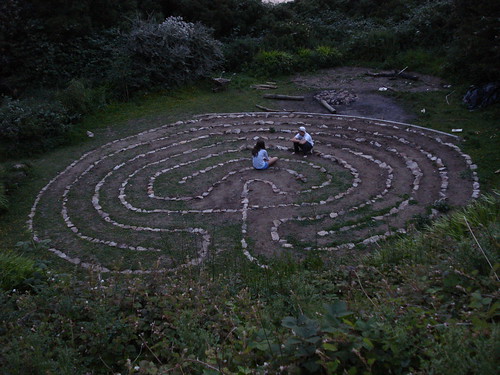
It's 95°F here in Washington, DC today, so there's no way in heck I'll be standing over a fire. So, it's virtual barbeque time for me. The steak on coals method isn't for me, but Betty Crocker's Outdoor Cook Book
The basic rules for fire building and control that follow will give you a fast start in the right direction, but only by firsthand experience does anyone develop that second sense that tells the expert how to make the outdoor grill produce reliable results.So, the first four rules are Do This; Seriously, Do This; No, Really, Do This; So You Didn't Do What We Told You To....Here's How To Fix. Then, two rules covering Leave Well Enough Alone, Already.
Rule One: Before you light your fire, collect or have easily at hand all of the fuel you expect to use--and a little more!
Rule Two: Once your pilot fire is kindled and burning well, add as readily as possible all of the rest of the fuel so that it can burn down all at once to an even bed of coals.
Rule Three: Use a little more fuel than actually necessary. Nothing is a wider open invitation to trouble than a fire that is too small.
Rule Four: When necessary to add fuel to a well-established fire--as it sometimes is during a long cooking period--add it at the edges and rake it in when well kindled. Never put the fresh fuel in the center as this reduces heat rapidly.
Rule Five:Allow plenty of time for the fire to reach its proper cooking heat. Half an hour is the minimum for charcoal briquets, and 45 minutes to an hour is safer.
Rule Six: Once your fire is well under way, disturb it as little as possible. Constant poking and raking breaks up pockets of heat and lowers temperature.
Rule Seven: Develop some stern method of kibitzer control. People who would not dream of regulating your kitchen oven seem unable to resist "helping" the oudoor chef by stirring up his fire. They mean well. Indeed, such activity usually shows the first gleam of determination to try outdoor cooking for themselves. But threaten them off with the tongs, if necessary. two firemasters is one too many.
I don't know that I've ever had a small fire be a wide open invitation to trouble before. Large fires, sure. There was a fire pit in Northern Ireland, and that was a wide open invitation to some contemplation. Well, for me, contemplation. For Alex, a teen pilgrim and firebug, I suppose a small fire is in fact a wide open invitation to, if not trouble, at least to a bigger fire.

Here at Take One Cookbook... we like to think thoughts of peace and not of affliction, so I would like you to disregard Betty Crocker's advise to threaten people with tongs. It's not very civil. Plus, you use those tongs on food -- don't muck 'em up on overly eager "firemasters."

No comments:
Post a Comment